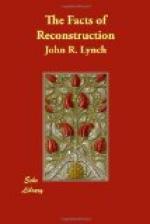The first election held in Mississippi under the Reconstruction Acts took place in 1867, when delegates to a Constitutional Convention were elected to frame a new Constitution. The Democrats decided to adopt what they declared to be a policy of “Masterly Inactivity,” that is, to refrain from taking any part in the election and to allow it to go by default. The result was that the Republicans had a large majority of the delegates, only a few counties having elected Democratic delegates. The only reason that there were any Democrats in the Convention at all was that the party was not unanimous in the adoption of the policy of “Masterly Inactivity,” and consequently did not adhere to it. The Democrats in a few counties in the State rejected the advice and repudiated the action of the State Convention of their party on this point. The result was that a few very able men were elected to the convention as Democrats,—such men, for instance, as John W.C. Watson, and William M. Compton, of Marshall County, and William L. Hemingway, of Carroll, who was elected State Treasurer by the Democrats in 1875, and to whom a more extended reference will be made in a subsequent chapter.
The result of the election made it clear that if the Democratic organization in the State had adopted the course that was pursued by the members of that party in the counties by which the action of their State Convention was repudiated, the Democrats would have had at least a large and influential minority of the delegates, which would have resulted in the framing of a constitution that would have been much more acceptable to the members of that party than the one that was finally agreed upon by the majority of the members of that body. But the Democratic party in the State was governed and controlled by the radical element of that organization,—an element which took the position that no respectable white Democrat could afford to participate in an election in which colored men were allowed to vote. To do so, they held, would not only be humiliating to the pride of the white men, but the contamination would be unwise if not dangerous. Besides, they were firm in the belief and honest in the conviction that the country would ultimately repudiate the Congressional Plan of Reconstruction, and that in the mean time it would be both safe and wise for them to give expression to their objections to it and abhorrence of it by pursuing a course of masterly inactivity. The liberal and conservative element in the party was so bitterly opposed to this course that in spite of the action of the State Convention several counties, as has been already stated, bolted the action of the convention and took part in the election.




